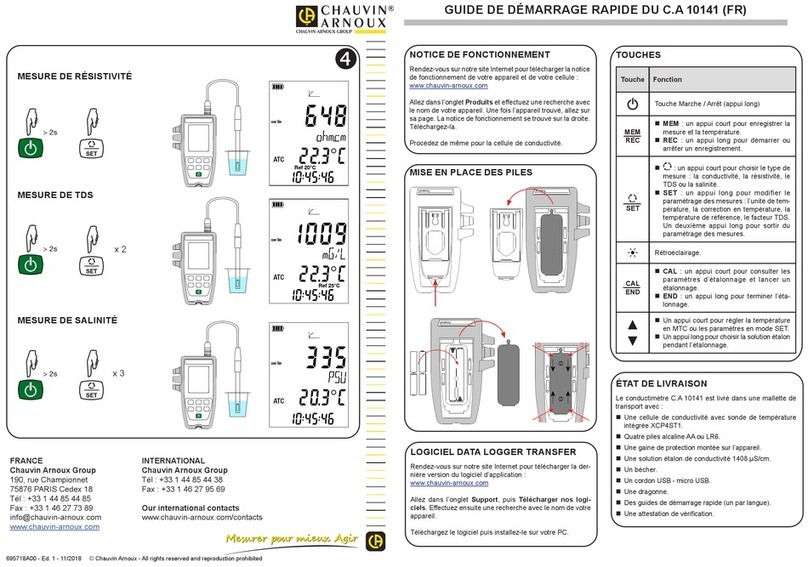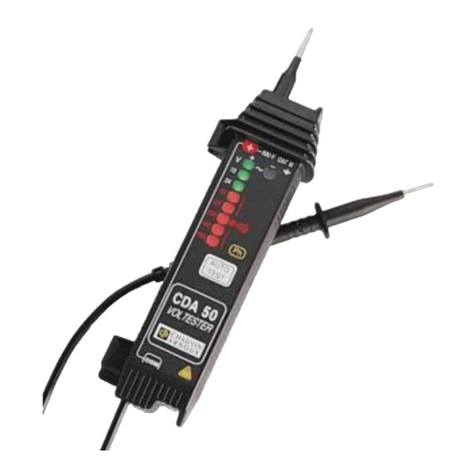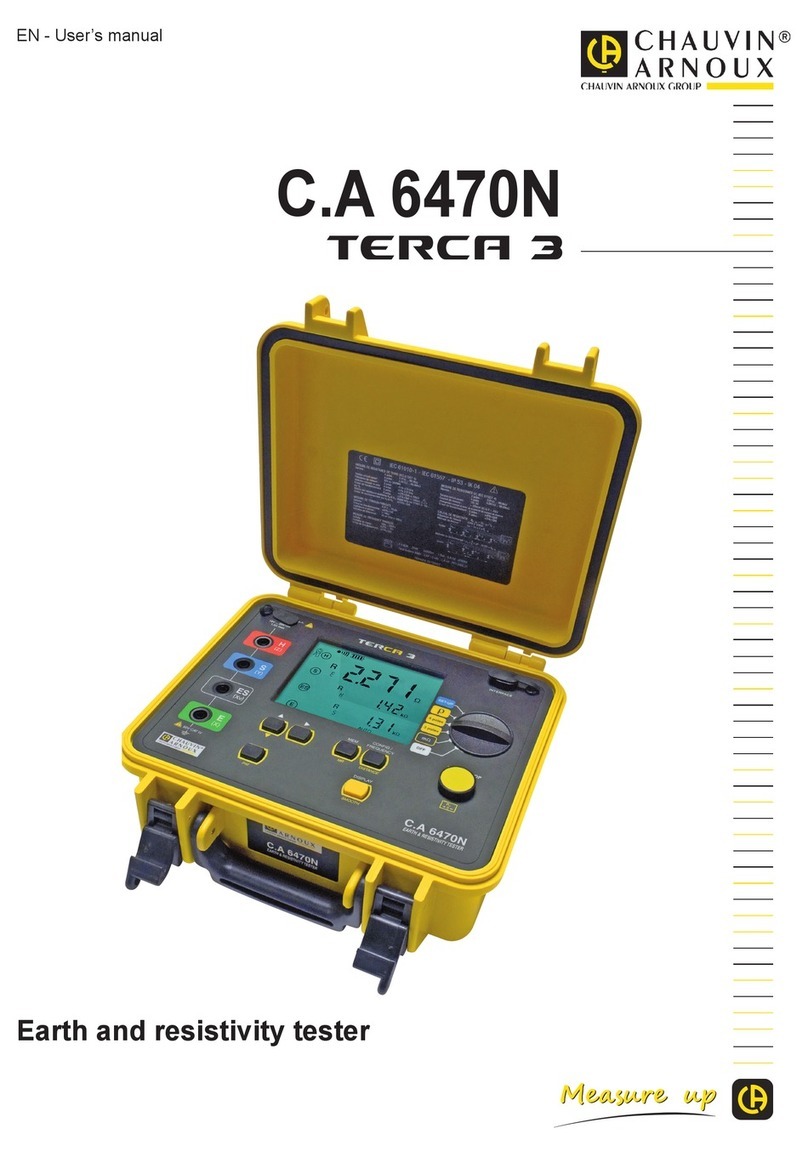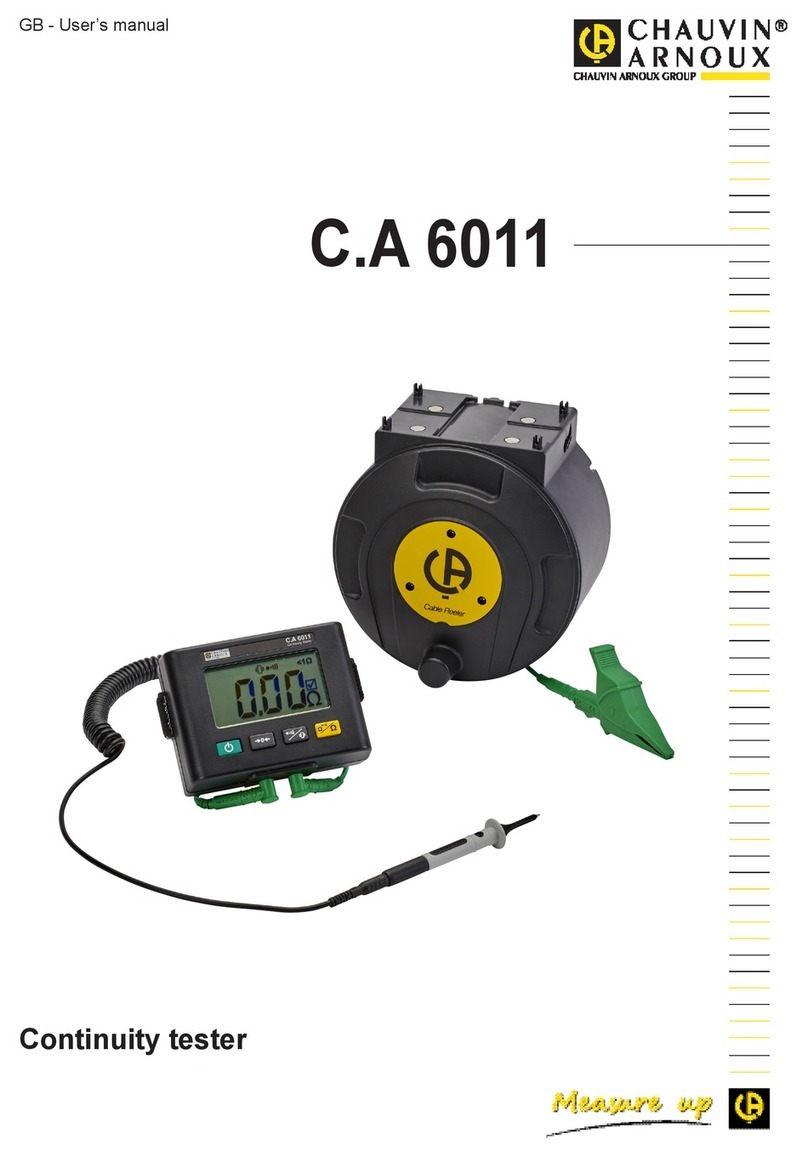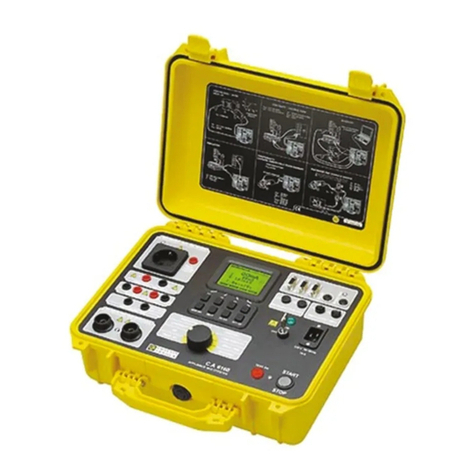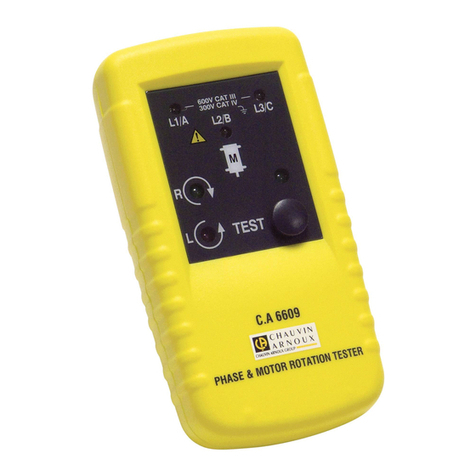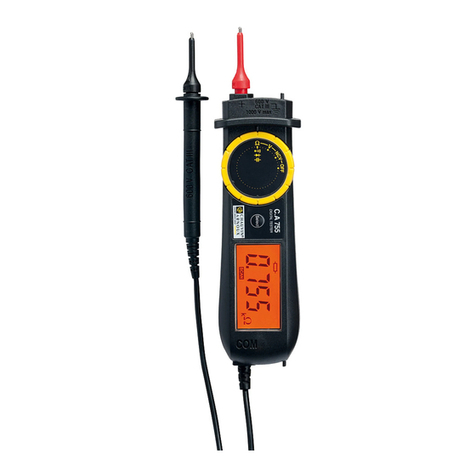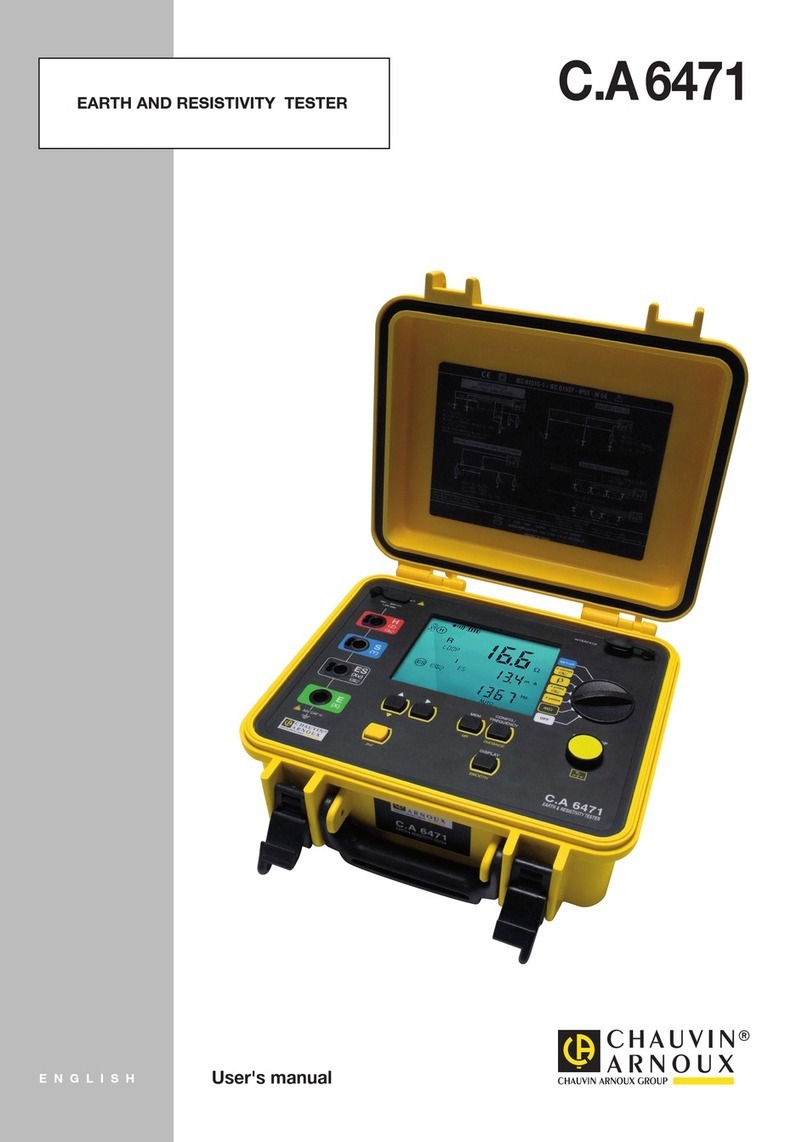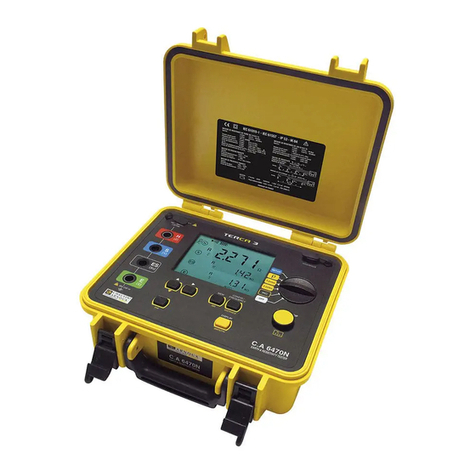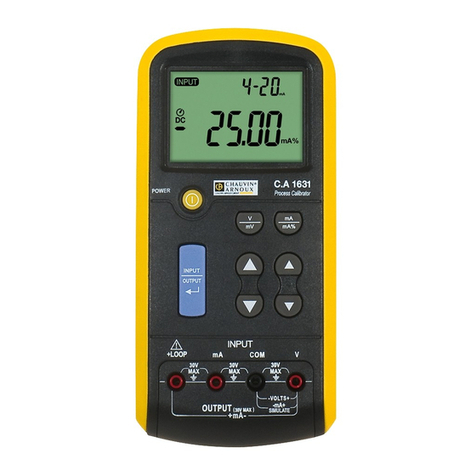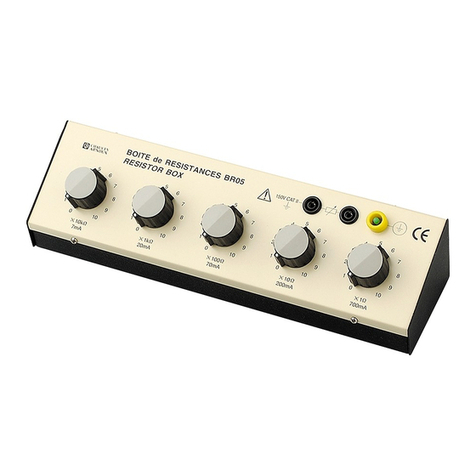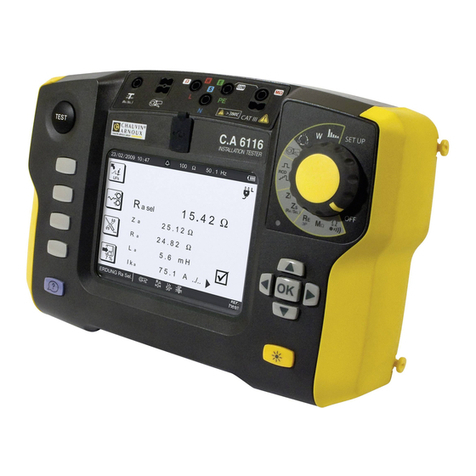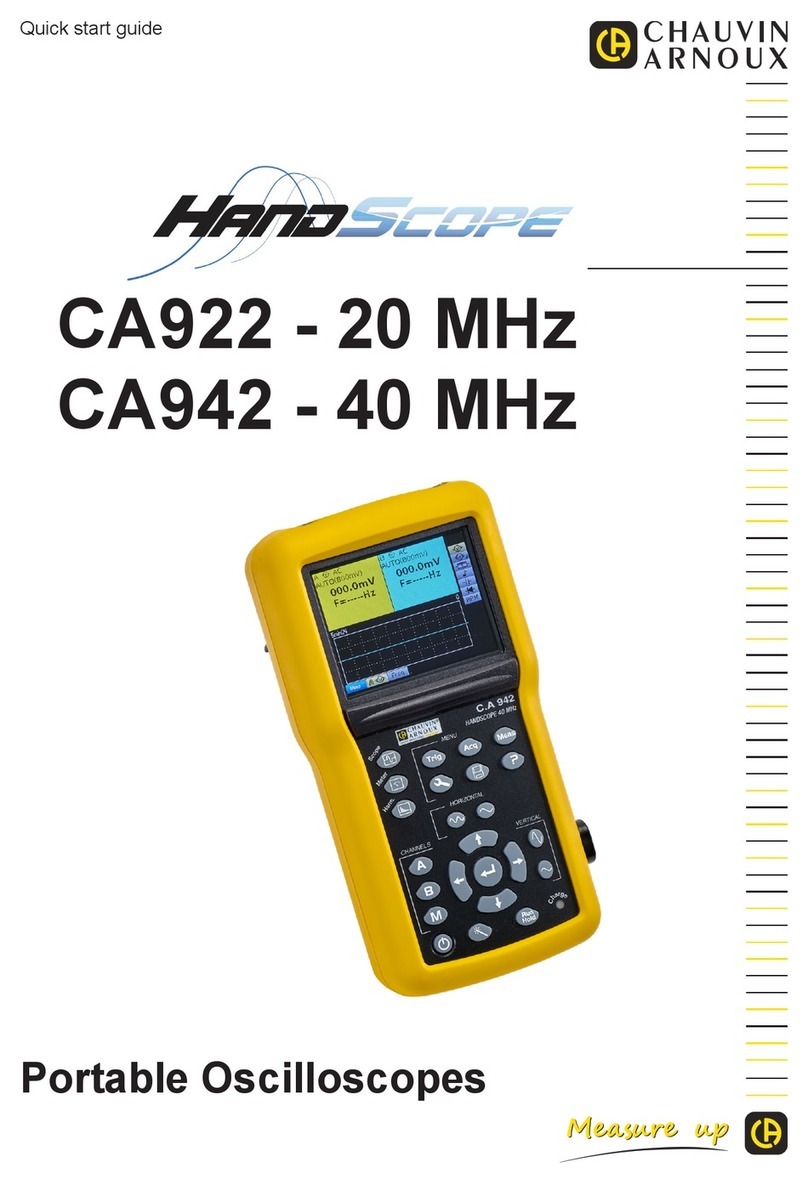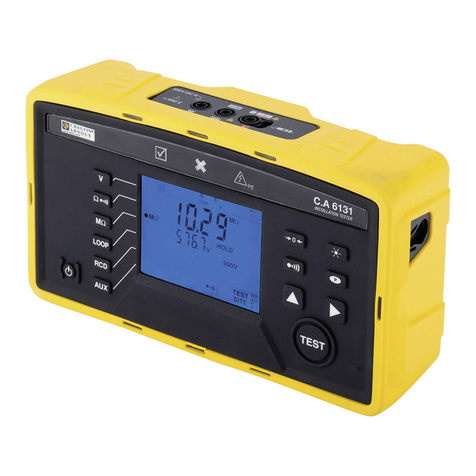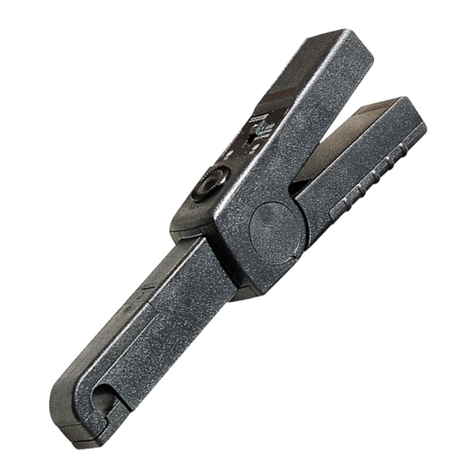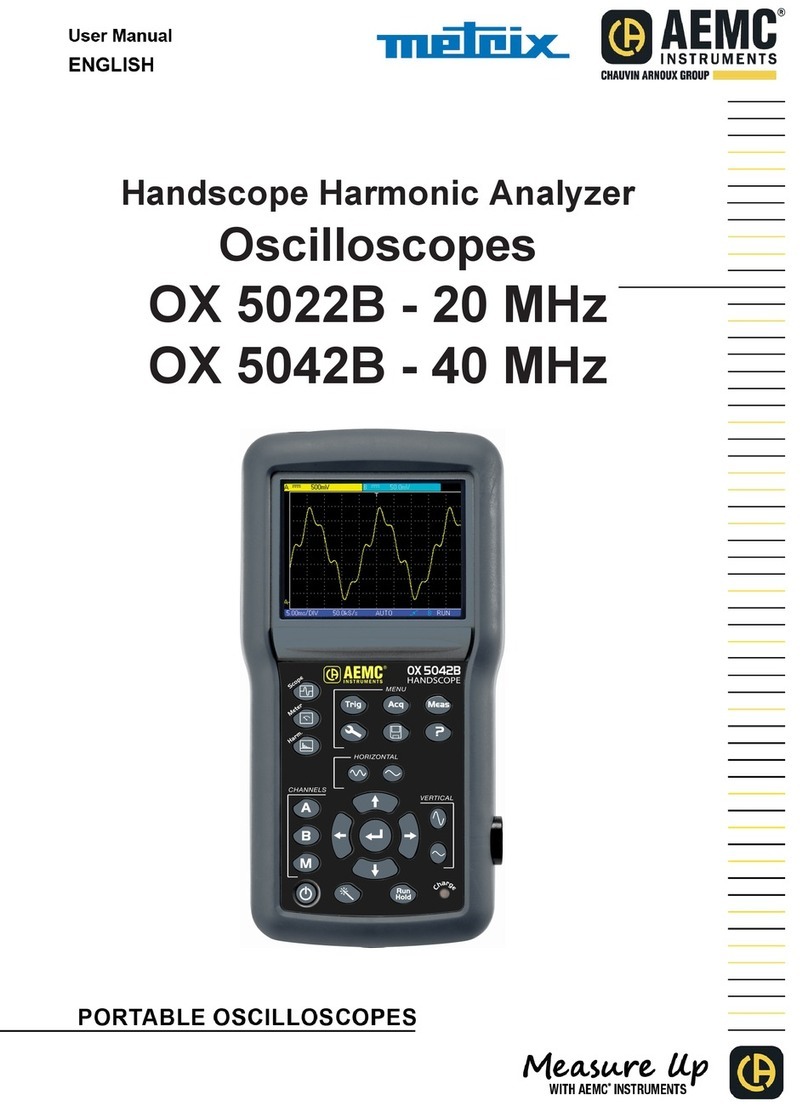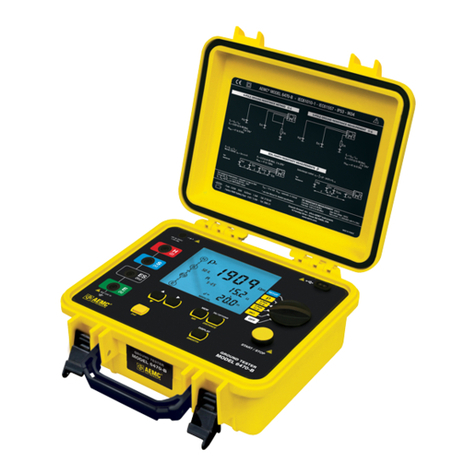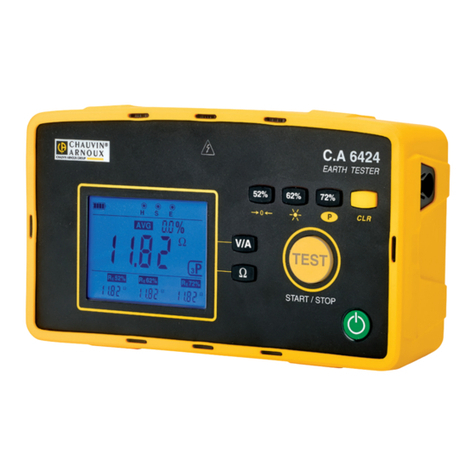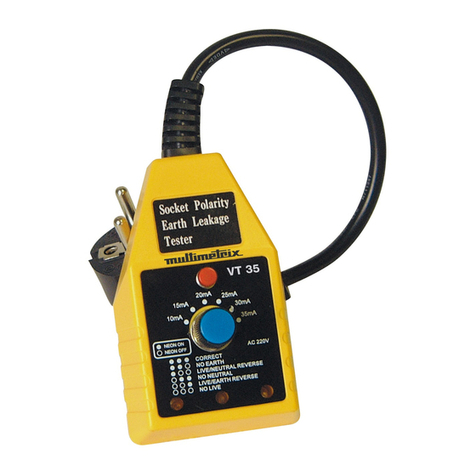Mode d’Emploi
User’s Manual
Bedienungsanleitung
Libretto d’Istruzioni
Manual de Instrucciones
Vous venez d’acquérir un TESTEUR DE TEN-
SION et nous vous remercions de votre confiance.
Pour obtenir le meilleur service de votre appareil :
■lisez attentivement ce mode d’emploi
■respectez les précautions d’emploi
POUR COMMANDER
■Testeurde tensionC.A745 .......P01191736Z
Livré avec une pile 9 V et ce mode d’emploi
■Accessoires
- Sacoche n°10 ..........................P01298012
- Dragonne ................................P03100824
■Rechange
-Pointede touche rouge..............P01103061Z
Significations du symbole
Attention ! Consulter le mode d’emploi avant
d’utiliser l’appareil.
Dans le présent mode d’emploi, les
instructions précédées de ce symbole, si elles
ne sont pas bien respectées ou réalisées,
peuvent occasionner un accident corporel
ou endommager l’appareil et les installations.
PRECAUTIONS D’EMPLOI
■Toujours procéder à un AUTO-TEST avant
d’utiliser le testeur.
■Tension maxi d’utilisation : 690V
■Ne pas utiliser sur une installation dont la
tension est supérieure à 600 V par rapport à
la terre et dont la catégorie de surtension est
supérieure à III.
■Nejamais procéderàuntestderésistancesur
un circuit sous tension. Cependant en cas de
fausse manoeuvre, protection jusqu’à 550V.
■Ne jamais toucher les pointes de touche
métalliques pendant un test.
Signification du symbole
Cet appareil est protégé par une isolation
double ou une isolation renforcée.Il ne néces-
site pas de raccordement à la borne de terre de
protection pour assurer la sécurité électrique.
FRANCAIS
ENGLISH
DEUTSCH
ITALIANO
ESPANOL
C.A 745
■TESTEUR DE TENSION
■VOLTAGE TESTER
■SPANNUNGSPRÜFER
■TESTER DI TENSIONE
■COMPROBADOR DE TENSION
09 - 2015
Code 691148A00 - Ed.4
ENGLISH....................................
DEUTSCH.................................
ITALIANO.............................
ESPAÑOL.................................
1 - PRÉSENTATION
Voir dessin en 10.Annexe
Le C.A 745 est un testeur visuel et sonore de
tension continue et alternative, de continuité et
de résistance. Il dispose également de la fonction
repéragephase/neutre.Sa tension maxi d’utilisation,
690V, permet les tests sur une installation triphasée
400 V/690 V tout en respectant la tension maxi par
rapport à la terre de 600 V. Ce testeur ne possède
pas de fusible et sa conception évite les risques de
court-circuit interne.
➀Pointe de touche (avec entraxe 19 mm)
➁
Garde anti-glissement pour éviter tout contact
accidentel avec un conducteur sous tension
➂Rampe à LED donnant la valeur de la tension
ou de la résistance
➃AUTO-TEST : touche de contrôle
➄Poussoir «continuité» au dos du boîtier
SOMMAIRE
1 - PRÉSENTATION.......................................
2 - AUTO-TEST...............................................
3 - TEST DETENSION......................................
4 - REPERAGE PHASE/NEUTRE...................
5 - TEST DE CONTINUITE ET DE RESISTANCE
6 - TEST DIODE .............................................
7 - CARACTÉRISTIQUES GÉNÉRALES........
8 - MAINTENANCE......................................
9 - GARANTIE.................................................
10 - ANNEXE....................................................
2 - AUTO-TEST
L’auto-test permet de contrôler le bon fonctionnement
du testeur dans son ensemble :des pointes de touche
aux diodes électroluminescentes (LED) via le cordon,
l’électronique, le buzzer et la pile 9 V.
NB : Ne jamais utiliser le testeur si l’auto-test
est négatif.
Mise en oeuvre
Appuyer sur la touche AUTO-TEST.
■La LED «+» et les LED 12 à 690 V s’allument
et le bip sonore fonctionne
■Court-circuiter les pointes de touche, avec la
touche AUTO-TEST toujours appuyée : la
LED «-» s’allume
Le testeur est en bon état de fonctionnement si
toutes les LED s’allument. Si non, changer la pile
9V (voir 8- Maintenance)et recommencerl’autotest.
3 - TEST DE TENSION
Toujours procéder à un AUTO-TEST avant
d’utiliser le testeur.
Ne pas appuyer sur le poussoir «continuité»
au dos du boîtier.
3.1 MISE EN OEUVRE
Mettre la pointe de touche rouge en place dans la
borne «+» verrouillable.Prendre le testeur en main,
sansappuyer sur latoucheAUTO-TESTetplacerles
pointes de touche aux bornes du circuit à contrôler.
La simple présence d’une tension assure le
fonctionnement automatique.
3.2 RECONNAISSANCE DU CONTINU OU DE
L’ALTERNATIF
■Les deux LED vertes «+» et «-» s’allument :
tension alternative
■La LED «+» s’allume : continu, le positif à la
pointe de touche du boîtier
■La LED «-» s’allume : continu, le négatif à la
pointe de touche du boîtier
■Aucune LED ne s’allume : pas de tension ou
tension < 12 V.
3.3 VALEUR DE LA TENSION
■2 LED vertes : 12 V et 24 V
■
5 LED rouges : 50 V, 127 V, 230 V, 400 V et 690 V
La dernière LED allumée donne le niveau de
tension en présence. Allumage à 85 % de la
tension nominale
: Emission d’un signal sonore continu
simultanément avec l’allumage des
LED rouges (U > 50 V)
En cas d’ensoleillement intense, la
perception visuelle de présence de
tension peut-être affectée.
3.4 CARACTÉRISTIQUES ET DOMAINE
D’UTILISATION
■Détection de tension : 12 V ≤U ≤690 V
■Fréquence : 0...400 Hz
■Tension maxi par rapport à la terre : 600 V
■Surcharge admissible:1000V eff.pendant 30s.
■Consommation : variable suivant la tension.
125 µA à 50 V et 1,7 mA à 690 V
■Impédance : 400 kΩ
■Temps de réponse : < 0,5 seconde
■Durée de test : illimité pour U ≤690 V eff.
4 - REPÉRAGE DE PHASE / NEUTRE
Toujours procéder à un AUTO-TEST avant
d’utiliser le testeur
Amener la pointe de touche noire au contact du
circuit à tester. En présence de phase (
U > 100 V
) la
LED «Ph» clignote.Dans certains cas la LED «Ph»
peut s’allumer en présence de charges statiques.
5-TESTDECONTINUITEETDERESISTANCE
Toujours procèder à un auto-test avant
d’utiliser le testeur. Ne jamais procèder à un test de
résistance sur un circuit sous tension.
5.1 MISE EN OEUVRE
Placer les pointes de touche aux bornes du
composant ou du circuit à contrôler. Appuyer sur le
poussoir «continuité» au dos du boîtier.
5.2 VALEUR DE RESISTANCE
■2 LED vertes : 300 kΩ et 60 kΩ (à 25 % près)
■1 LED rouge : 2 kΩ
La dernière LED allumée donne l’évaluation
de la résistance en présence; valeur inférieure
à celle marquée sur le testeur.
5.3 TEST SONORE DE CONTINUITE
Il y a émission d’un signal sonore continu
simultanément à l’allumage de la LED rouge «
« : R ≤2 kΩ
5.4 CARACTÉRISTIQUES
■Impédance : 12 kΩ
■Courant de test maxi : 100 µA
■Tension de test à vide : 3,8 V
■
Polarité positive sur la pointe de touche du boîtier
■Temps de réponse : < 0,5 seconde
■Protection : jusqu’à 550 V
(consommation < 20 mA pour 230 V. Ne fait
pas disjoncter les différentiels 10 et 30 mA)
6 - TEST DIODE
La mise en oeuvre du test diode est identique à
celle du test de continuité; pour vérifier le sens de
conduction (ou inverse) des diodes, transistors, ...
7 - CARACTERISTIQUES GENERALES
7.1 CONDITIONS D’ENVIRONNEMENT
Conditions à respecter pour garantir le bon
fonctionnement
■Utilisation en intérieur
■Température : -10 ... +55°C
■Humidité relative : 10 ... 90 % HR
■Altitude : jusqu’à 2000 m
7.2 ALIMENTATION
■1 pile 9 V (6 F 22, 6 LF 22 ou NEDA 1604)
■Autonomie :
- 5000 tests de 5 secondes avec pile alcaline
(6 LF 22)
- 3500 tests de 5 secondes avec pile ordinaire
7.3 DIMENSIONS ET MASSE
■Dimensions : 193 x 47 x 36 mm (hors tout)
Masse : 170 g (avec pile)
■Longueur du cordon : 1,20 m
■
Diamètre des pointes de touche : 2mm et 3,7 mm
7.4 CONFORMITÉ AUX NORMES
■DIN-VDE 0680 - Partie 5 : norme allemande
définissant les testeurs bipolaires de tensions.
■Sécurité électrique
(selon IEC 61010-1, IEC 61010-2-033)
- Double isolation
- Catégorie d’installation III
- Degré de pollution 2
-
Tension assignée :600V (par rapport à la terre)
■Etanchéité (selon NF EN 60529) :
Indice de protection IP 50
■Compatibilité électromagnétique :
Émission et immunité en milieu industriel selon
EN 61326-1.
8 - MAINTENANCE
Pour la maintenance,utilisez seulement
les pièces de rechange qui ont été
spécifiées. Le fabricant ne pourra être tenu pour
responsable de tout accident survenu suite
à une réparation effectuée en dehors de son
service après-vente ou des réparateurs agréés.
8.1 REMPLACEMENT DE LA PILE
Toujours déconnecter le testeur de toute
source électrique avant d’ouvrir le boîtier.
■
Démonter les deux vis du demi-boîtier inférieur.
■Remplacer la pile 9 V défectueuse par une pile
de même type (6 F 22, 6 LF 22 ou NEDA 1604)
et refermer le boîtier avant utilisation.
8.2 ENTRETIEN
■Nettoyagedu boîtier avecun chiffonlégèrement
imbibé d'eau savonneuse. Rincer avec un
chiffon humide. Ensuite sécher rapidement
avec un chiffon ou de l'air pulsé.
8.3 STOCKAGE
Si le testeur n’est pas mis en service pendant une
durée dépassant 60 jours, enlevez la pile et stockez
la séparément.
8.4 VÉRIFICATION PÉRIODIQUE
Comme tous les appareils de mesure
oud’essais,unevérificationpériodique
est nécessaire.
Nous vous conseillons une vérification annuelle de
cet appareil. Pour les vérifications et étalonnages,
adressez- vous à nos laboratoires de métrologie
accrédités (renseignements et coordonnées sur
demande) ou à l'agence de votre pays.
8.5 RÉPARATION
Pour les réparations sous garantie et hors garantie,
contactez votre agence commerciale Chauvin
Arnoux la plus proche ou votre centre technique
régional Manumesure qui établira un dossier de
retour et vous communiquera la procédure à suivre.
Coordonnées disponibles sur notre site :
http://www.chauvin-arnoux.com
ou par téléphone aux numéros suivants :
02 31 64 51 55 (centre technique Manumesure),
01 44 85 44 85 (Chauvin Arnoux).
Pour les réparations hors de France métropolitaine,
sous garantie et hors garantie, retournez l'appareil
à votre agence Chauvin Arnoux locale ou à votre
distributeur.
9 - GARANTIE
Notre garantie s’exerce, sauf stipulation
expresse, pendant douze mois après la date
de mise à disposition du matériel (extrait de nos
Conditions Générales de Vente, communiquées
sur demande).
Meaning of the symbol
Warning ! Please refer to the User’s Manual
before using the instrument.
In this User’s Manual, the instructions preceded
by the above symbol, should they not be carried
out as shown, can result in a physical accident
or damage the instrument and the installations.
SAFETY PRECAUTIONS
■ Always make an AUTO-TEST before using
the tester.
■ Maximum operating voltage: 690 V.
■ Do not use on an installation in which the
voltage is greater than 600 V in relation to the
earth, and which has an overvoltage category
greater than III.
■ Never make a resistance test on a live circuit.
However, in case of incorrect operation,
protection up to 550 V.
■
Never touch the metallic test prods during a test.
TO ORDER
■ TesterC.A 745 ............................P01191736Z
Supplied with a 9 V battery and this User’s manual
■ Accessories
-Holster n°10 .................................P01298012
-Wrist strap...................................P03100824
■ Spare
- Red test prod ...........................P01103061Z
Thank you for purchasing a VOLTAGE TESTER.
To get the best service from this instrument:
■read this user’s manual carefully
■respect the safety precautions detailed
English
Meaning of the symbol
This device is protected by a double insulation
or by a reinforced insulation. No linking is
required from the protection earth terminal to
ensure the electrical security.
SUMMARY
1 - PRESENTATION .........................................
2 - AUTO-TEST ................................................
3 - VOLTAGE TEST ..........................................
4 - PHASE/NEUTRAL IDENTIFICATION ..........
5 - CONTINUITY AND RESISTANCE TEST ....
6 - DIODE TEST ...............................................
7 - GENERAL SPECIFICATIONS .....................
8 - MAINTENANCE ..........................................
9 - WARRANTY ................................................
10 - APPENDIX ..................................................
1 - PRESENTATION
See drawing 10.Appendix
The C.A 745 is an audible and visual DC and AC
voltage, continuity and resistance tester. It also has
a phase/neutral identification function. Its maximum
operating voltage, 690 V, allows tests on a 3-phase
400 V/ 690 V installation whilst respecting the max
voltage in relation to the earth of 600 V.
This tester does not have a fuse and its design
avoids risks of internal short circuit.
➀Test prods (with 19 mm gap)
➁Non-slip guard to avoid any accidental contact
with a live conductor
➂Ramp of LED’s giving the value of the voltage
➃AUTO-TEST: test button
➄Continuity button on the back of the case
2 - AUTO-TEST
The auto-test allows testing of the correct operation
of the complete tester: test prods with light emitting
diodes (LED), via the lead, the electronics and the
9 V battery.
NB:Never use the tester if the auto-test is negative.
How to do the auto-test
Press the AUTO-TEST button
■ The «+» LED and the 12 to 690 V LED’s light
up, and the buzzer comes on.
■ Short-circuitthe test prods,withthe AUTO-TEST
button still pressed: the «-» LED lights up.
The tester is in good working condition if all the
LED’s light.If not, change the 9V battery (see §.
8. Maintenance) and do the auto-test again.
3 - VOLTAGE TEST
Always do an AUTO-TEST before using
the tester. Do not press the «continuity» button on
the back of the tester.
3.1 HOW TO USE
Place the red test prod in position in the lockable
«+» terminal. Hold the tester in your hand, without
pressingtheAUTO-TESTbutton,and place thetest
prods at the terminals of the circuit to be tested.
The simple presence of a voltage ensures
automatic operation.
3.2 RECOGNITION OF DC OR AC
■
BothgreenLED’s«+» and «-»lightup:ACvoltage
■ The «+» LED lights: DC, positive at the test
prod of the tester
■ The «-» LED lights: DC, negative at the test
prod of the tester
■ No LED lights up:no voltage or voltage < 12V.
3.3 VALUE OF THE VOLTAGE
■ 2 green LED’s: 12 V and 24 V
■
5 red LED’s: 50 V, 127V, 230 V, 400 V and 690V
ThelastLED litgivesthelevelofvoltagepresent.
Lights to 85 % of the nominal voltage.
: Emissionofcontinuousaudiblebuzzer
simultaneouslywith lighting ofthered
LED’s (U > 50 V).
In case of bright sunlight, the visual
perceptionof the presence of voltage
may be affected.
3.4 SPECIFICATIONS AND DOMAIN OF USE
■Voltage detection: 12 V ≤U ≤690 V
■Frequency: 0...400 Hz
■
Maximum voltage in relation to the earth: 600 V
■Permited overload:1000 Vrms for 30 seconds
■
Consumption:variabledependingonthevoltage.
125 µA at 50 V and 1.7 mA at 690 V
■Impedance: 400 kΩ
■Response time: < 0.5 seconds
■Duration of test: unlimited for U ≤690 Vrms.
4 - PHASE / NEUTRAL IDENTIFICATION
Always perform an AUTO-TEST before
using the tester
Bring the black test prod into contact with the
circuit to be tested. In the presence of phase
(U > 100 V) the «Ph» LED flashes. In certain
cases, the «Ph» LED may light up in the presence
of static charges.
5 - CONTINUITY AND RESISTANCETEST
Always perform an AUTO-TEST before
using the tester. Never make a resistance
test on a live circuit
5.1 HOW TO USE
Placethe testprodsatthe terminals of thecomponent
orthecircuittobetested.Pressthe«continuity»button
on the back of the tester.
5.2 VALUE OF RESISTANCE
■2 green LED’s: 300 kΩand 60 kΩ(to nearest
25%)
■1 red LED: 2 kΩ
Thelast LED lit gives the valueofthe resistance
present; value below that marked on the tester.
5.3 CONTINUITY SOUND TEST
A continuous buzzer sounds simultaneously with
lighting of the red LED « »: R ≤2 kΩ
5.4 SPECIFICATIONS
■Impedance: 12 kΩ
■Max test current: 100 µA
■Empty voltage test: 3.8 V
■Positive polarity on the test prod of the tester
■Response time: < 0.5 seconds
■
Protection: up to 550 V (consumption < 20 mA
for 230 V. Does not trigger 10 and 30 mA RCD’s)
6 - DIODE TEST
Thediodetestisdoneinexactlythe same wayas the
continuity test; to check the direction of conduction
(or reverse) of diodes, transistors,...
7 - GENERAL SPECIFICATIONS
7.1 ENVIRONMENTAL CONDITIONS
Conditions to respect to guarantee good
operation
■Use indoors.
■Temperature: -10...+55°C
■Relative humidity: 10...90% RH
■Altitude: up to 2000 m
7.2 POWER SUPPLY
■1 battery 9 V (6 F 22, 6 LF 22 or NEDA 1604)
■Battery life:
- 5000 tests of 5 seconds with alkaline battery
(6 LF 22)
- 3500 tests of 5 seconds with ordinary battery
7.3 DIMENSIONS AND WEIGHT
■Dimensions: 193 x 47 x 36 mm (outside)
Weight: 170 g (with battery)
■Length of lead: 1.20 m
■Diameter of test prods: 2 mm and 3.7 mm
7.4 CONFORMITY WITH STANDARDS
■DIN - VDE 0680 - Part 5: German standard
defining dual pole voltage testers.
■Electrical safety
(to IEC 61010-1, IEC 61010-2-033)
- Double insulation
- Installation category III
- Degree of pollution 2
- Rated voltage: 600 V (in relation to the earth)
■Watertightness (to NF EN 60529):
Protection index IP 50
■Electromagnetic compatibility:
Emissions and immunity in an industrial setting
compliant with EN 61326-1
8 - MAINTENANCE
For maintenance, use only specified
spare parts. The manufacturer will not be held
responsible for any accident occurring following
a repair done other than by its After Sales Service
or approved repairers.
8.1 REPLACINGTHE BATTERY
Always disconnect the tester from any
electric source before opening the case
■Remove the two screws from the lower half of
the case
■ Replace the used 9 V battery by a battery of
the same type (6 F 22, 6 LF 22 or NEDA 1604)
■Close the case again before using the tester
8.2 CLEANING
■Clean the case with a cloth slightly moistened
with soapy water. Wipe off with a damp cloth.
Then dry quickly with a cloth or in a hot air flow.
8.3 STORAGE
Ifthetesterisnotusedformore than 60 days,remove
the battery and store it separately.
8.4 PERIODIC VERIFICATION
Like all measuring or testing devices, the
instrument must be checked regularly.
This instrument should be checked at least once a
year.For checks and calibrations, contact one of our
accredited metrology laboratories (information and
contact details available on request), at our Chauvin
Arnoux subsidiary or the branch in your country.
8.5 REPAIR
For all repairs before or after expiry of warranty,
please return the device to your distributor.
9 - WARRANTY
Our guarantee is applicable for twelve months
after the date on which the equipment is made
available (extract from our General Conditions of
Sale, available on request).
BESTELLANGABEN
■Spannungsprüfer C.A 745 ............P01191736Z
Lieferung mit 9 V-Batterie und Bedienungsanleitung
■Zubehör
- Tragetasche Nr. 10 .....................P01298012
-Trageschlaufe...............................P01100824
■Ersatzteile
- Rote Tastspitze .......................P01103061Z
Deutsch
Bedeutung des Zeichens
Achtung ! Beachten Sie vor Benutzung
des Gerätes die Hinweise in der Bedienungs-
anleitung.
Falls die Anweisungen die in vorliegender
Bedienungsanleitung nach diesem Zeichen
erscheinen nicht beachtet bzw. nicht ausgeführt
werden, können körperliche Verletzungen
verursacht bzw. das Gerät und die Anlagen
beschädigt werden.
Bedeutung des Zeichens
Das Gerät ist schutzisoliert bzw.durch eine verstär-
ke Isolierung geschützt. Ein Anschluβan einem
Erdleiter ist für die Gewährleistung der elektrischen
Sicherheit nicht erforderlich.
SICHERHEITSHINWEISE
■FührenSievorBenutzungdesGerätsstets den
Selbsttest durch.
■Die maximal zulässige Eingangsspannung
beträgt 690 V.
■Das Gerät niemals an Anlagen mit mehr als
600V.Spannung gegenüberErdebzw.miteiner
Überspannungsklasse größer als III benutzen.
■Führen Sie niemals eine Widerstandsprüfung
an einer Schaltung durch, die unter Spannung
steht. Bei Fehlbedienung ist das Gerät jedoch
bis 550 V geschützt.
■Berühren Sie niemals die metallischen
Tastspitzen während einer Prüfung.
Wir bedanken uns bei Ihnen für den Kauf des
SPANNUNGSPRÜFERS und das damit
entgegengebrachte Vertrauen. Um die besten
Ergebnisse mit Ihrem Meßgerät zu erzielen, bitten
wir Sie :
■die vorliegende Bedienungsanleitung auf-
merksam zu lesen und die darin enthaltenen
Sicherheitshinweise zu beachten
INHALTSÜBERSICHT
1 - GERÄTEVORSTELLUNG ..............................
2 - SELBSTTEST.................................................
3 - SPANNUNGSPRÜFUNG ..............................
4 - ERKENNUNG PHASE/NULLEITER ..............
5 - DURCHGANGS- UND
WIDERSTANDSPRÜFUNG ..........................
6 - DIODENTEST................................................
7 - ALLGEMEINE TECHNISCHE DATEN ..........
8 - WARTUNG....................................................
9 - GARANTIE.....................................................
10 - ANHANG........................................................
1 - GERÄTEVORSTELLUNG
Siehe Abbildung 10- Anhang
Der C.A 745 ist ein Spannungsprüfer für Gleich-
und Wechselstrom, sowie ein Durchgangs- und
Widerstandsprüfer mit optischer und akustischer
Anzeige. Außerdem zeigt er Phase und Nulleiter
an.Die maximal zulässige Eingangsspannung von
690 V ermöglicht auch Prüfungen an Drehstrom-
Anlagen mit 400 V/690 V unter Einhaltung der
maximalen Spannung gegenüber Erde von 600 V.
DerPrüferbesitzt keineSchmelzsicherungundsein
AufbauverhindertzuverlässiginterneKurzschlüsse.
➀Isolierte Tastspitzen (mit 19 mm Abstand)
➁Gleitschutzring, verhindert unbeabsichtigtes
Abrutschen der Hand und Berührung der Leiter
➂LED-Rampe zur Anzeige der Spannung bzw.
des Widerstands
➃AUTO-TEST : Selbsttest des Geräts
➄Tastefür Durchgangsprüfungaufder Rückseite
2 - SELBSTTEST
Mit dem Selbsttest können Sie sämtliche Funktionen
des Geräts prüfen:Tastspitzen, LED-Anzeige, Kabel,
Elektronik, Prüfsummer und Batterie.
Hinweis:Den Prüferbei nichterfolgreichemSelbsttest
niemals benutzen !
Selbsttest durchführen:
Taste AUTO-TEST drücken
■LED “+”und die LEDs von “12”bis “690”leuchten;
außerdem ertönt der Summer.
■Tastspitzen kurzschließen und Taste AUTO-
TEST gedrückt halten: die LED “-” muß leuchten.
Wenn alle LEDs richtig leuchten und der Summer
ertönt, ist der Prüfer in Ordnung, andernfalls die 9
V-Batterie auswechseln (siehe Kapitel 8 Wartung)
und Selbsttest erneut durchführen.
http://www.chauvin-arnoux.com
190, rue Championnet - 75876 PARIS Cedex 18 - FRANCE
Tél. : +33 1 44 85 44 85 - Fax : +33 1 46 27 73 89 - info@chauvin-arnoux.fr
Export :Tél.: +33 1 44 85 44 86 - Fax :+33 1 46 27 95 59 - export@chauvin-arnoux.fr
Deutschland - Ohmstraße 1 - 77694 KEHL / RHEIN
Tel: (07851) 99 26-0 - Fax: (07851) 99 26-60
España - C/ Roger de Flor N° 293, Planta 1 - 08025 BARCELONA
Tel: 902 20 22 26 - Fax: 934 59 14 43
Italia - Via Sant’Ambrogio, 23/25 - 20846 MACHERIO (MB)
Tel: 039 245 75 45 - Fax: 039 481 561
Österreich - Slamastrasse 29/2/4 - 1230 WIEN
Tel: 01 61 61 961-0 - Fax: 01 61 61 961-61
Schweiz - Moosacherstrasse 15 - 8804 AU / ZH
Tel: 044 727 75 55 - Fax: 044 727 75 56
UK - Unit 1 Nelson Ct - Flagship Sq - Shaw Cross Business Pk
Dewsbury, West Yorkshire - WF12 7TH
Tel: 01924 460 494 - Fax: 01924 455 328
MIDDLE EAST - P.O BOX 60-154 - 1241 2020 Jal el dib
BEIRUT - LEBANON
Tel: (01) 890 425 - Fax: (01) 890 424
China - Shanghai Pujiang Enerdis Inst. CO. LTD - 3 F, Building 1
N° 381 Xiang De Road - Hongkou District - 200081 SHANGHAI
Tel: +86 21 65 21 51 96 - Fax: +86 21 65 21 61 07
USA - d.b.a AEMC Instruments
200 Foxborough Blvd, Foxborough - MA 02035
Tél : (508) 698-2115 - Fax : (508) 698-2118
